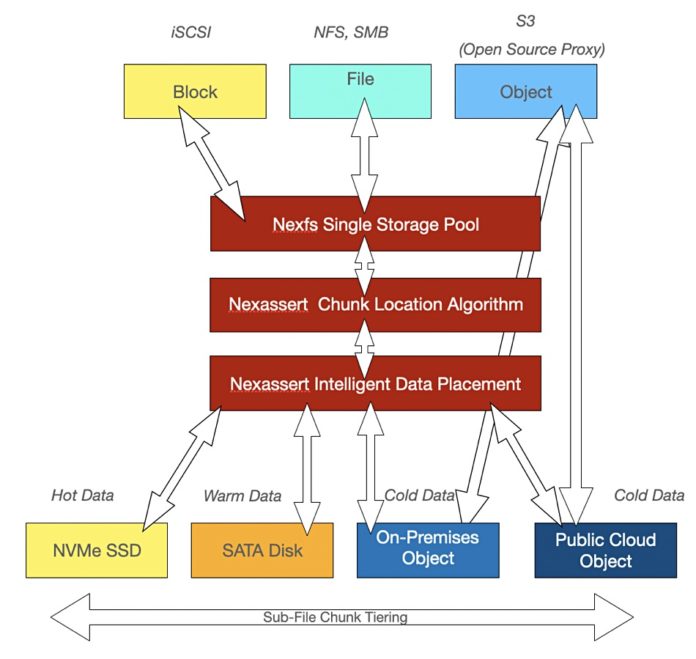NexuStorage’s Nexfs software serves block and file data from an object-backing store using sub-file chunking to reduce data movement and help data tiering, and claims great tier-one storage cost savings and good performance.
It has devised Nextassert software to do this without traditional data mapping indices, relational or NoSQL databases, manifests, stub files or symlinks. The company is a nine-month-old founder-funded startup based in New Zealand, and briefed a virtual IT Press Tour on its technology
Founder Glen Olsen, an ex-product manager at DataCore-acquired Caringo, said his Nexfs technology removes the gap between the worlds of file and block storage on the one hand and object storage on the other, with the object storage either on-premises or in the public cloud. Nexfs delivers, he said, a unified, intelligent, cost-effective, massively scalable, data-lifecycle-enabled, storage system that can provide an up to 95 per cent reduction in primary storage capacity.
The software runs on industry-standard servers and is available as a no-charge, downloadable Community Edition, with subscription-based, SLA-backed support coming soon.
Nexfs
Nexfs is a file system. It splits files into chunks of between 1MB and 8MB in size and stores these chunks on three tiers of media: fast SSDs, slower SATA disk drives, and slower-still object storage. Nexfs presents data through either block or file interfaces, with iSCSI, NFS and SMB/CIFS interfaces supported. There is no direct access to the underlying object storage, although an open source web proxy providing S3 access is on the roadmap.

Chunks are placed on the hot, warm or cold tiers according to their access profile or personality and can be moved up or down a tier by a SmartTier function. This background process uses low and high tide so-called watermarks to decide if and when and how aggressively to move data between the tiers, with object storage regarded as the infinitely scalable back-end. Its migration of data between tiers can be triggered by file closure, a change in a file data chunk, and/or according to a set time schedule.
SmartProtect automatically copies data in the hot tier to the cold object tier and also copies POSIX file metadata to the hot tier and to the object tier. This means primary data is still available after a drive or system failure.
SmartClone puts cloned copies of files on an object storage tier for protection or distribution. If a single client changes part of the file, the changed chunks are unique to that client.
The actual storage hardware can be local drives on servers, a SAN, or on-premises object stores — for example, from MinIO, Cloudian and Scality, and AWS. The object access method is S3.
Because the underlying file data is chunked, its access time is lower than that needed for a full file access. Chunks from a file can reside on different tiers:

In effect a chunk is an object, and sets of chunks make up a file or, in the block case, a volume. There can be millions of chunks, and mapping their location on the storage drives and their relationship with their parent file is what the Nextassert software accomplishes.
Nextassert
NexuStorage claims its sub-file chunk technology with Nexassert allows massive multi-terabyte sized files to be stored in the cloud or object storage and treated as though they reside on traditional block storage.
Olsen said data mapping indices, databases or manifests are a performance bottleneck and can cause data loss if they are corrupted or destroyed. Nextassert sidesteps both problems.

He said: “This works because we don’t have a data location index and Nexfs can actually calculate where the data is.” Nexassert patent-pending software can (apparently) directly locate and access data belonging to a single file that resides on different storage classes without maintaining a separate index or manifest. How? We don’t know.
Olsen’s LinkedIn profile says he has filed a patent called “Addressing file data chunks over a REST interface without maintaining a file data chunk database, index or manifest.” We haven’t been able to find any more details than this.
It seems to us that the Nextassert technology will be crucial to the delivery of Nexfs’s performance and scalability.
NexuStorage company
Glen Olsen is the founder, funder and CEO of NexuStorage. Development has been done by up to 50 external contractors. This is the typical Silicon Valley startup business model, and it’s not unusual according to him. The entire time at Caringo, he said, “I was … a contractor. I was never actually a permanent employee. And to be honest, over time, 90 per cent of Caringo’s work force was the same — they were all contractors.They had very few permanent employees.”
He said NexuStorage is a pre-revenue company and, once it starts earning revenue, then it may have permanent employees.
Alternatives
Open source Ceph provides file, block and data access using an underlying object store.
Pavilion Data provides block, file, and object access from its all-flash hardware, claiming it’s the most performant, dense, scalable, and flexible storage platform in the universe.
StorONE provides file, block and object storage on the same drives, supporting all drive types — NVMe, SAS, SATA SSDs and HDDs — in the same server.
NexuStorage will need to have advantages not shared by these products to make headway in the market.
Comment
This is a courageously funded startup with unique software technology that effectively includes data lifecycle management and could provide an effective way of reducing primary storage usage. We’ll watch its progress with interest.








